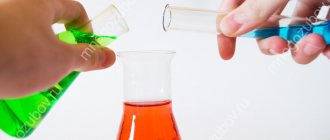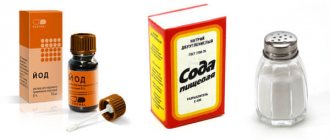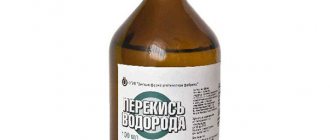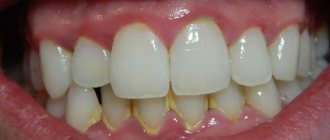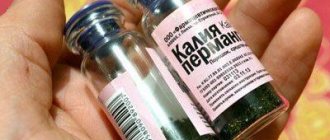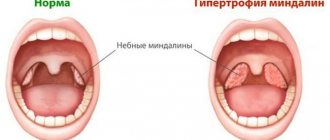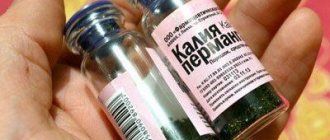12/21/2021
69 563
12 minutes
Co-author, editor and medical expert – Maksimov Alexander Alekseevich.
During seasonal epidemics, our body is susceptible to attack by many pathogens. Such diseases may be accompanied by a sore throat. Its common cause is tonsillitis - acute, predominantly bacterial inflammation of the tonsils or exacerbation of an existing infectious process. In the vast majority of cases, acute tonsillitis has a viral etiology. In second place in the number of causes of throat diseases are streptococci of various types. Viruses weaken the body's defenses by suppressing the ability of human immune cells to neutralize and absorb infectious agents. Damaged epithelial villi cannot cope with their function, creating conditions for mucus stagnation. The walls of the pharynx become swollen, hyperemic, and purulent films may form on their surface. The patient experiences pain when swallowing, cough, and general malaise.
An important component of complex treatment is gargling. This method allows you to mechanically clean the mucous membrane of microbial bodies, viruses, their waste products, pus, and moisturize the epithelium of the pharynx.
Depending on the composition of the rinse solution, an anti-inflammatory or antiseptic effect is realized and the intensity of pain is reduced. It is important to remember that rinsing alone may not be enough; more effective treatment includes a set of measures.
In this article we will look at the principles of local therapy.
Up to contents
Is it possible to gargle with salt?
Rinse is used for sore throat, runny nose, otitis, various pathologies of the ENT organs: acute and chronic tonsillitis, purulent processes in the tonsils, pharyngitis.
At certain concentrations, the salt solution has different therapeutic effects.
Hypertonic dilution of sodium chloride (osmotic pressure is greater than that in the tissues) relieves swelling, reducing sore throat, has antimicrobial activity, thins thick mucus, pus, and helps restore the draining function of the tonsils.
A saline solution with a salt concentration of 0.9% mechanically cleanses the walls of the pharynx from bacteria, viruses, dead cells, and moisturizes the mucous membrane of the oropharynx1.
To reduce the risk of infection, it is advisable to irrigate the nasal cavity and oropharynx after visiting crowded places or communicating with a sick person.
Up to contents
How often should you gargle with salt?
Before taking independent measures to combat the infection, consult a specialist. Only a doctor can make the correct diagnosis and prescribe the right medications. Recovery depends on adherence to the regimen, the correct selection of medications and therapies.
You should gargle with a salt solution 3-4 times a day, for up to 5 days in a row (the duration of treatment in each case is determined individually). But since table salt is not a medicine, treatment with proven antiseptics is necessary (for example, Hexoral ® rinse solution or Hexoral ® spray, chlorhexidine, and others).
Many patients ask the question: “Which salt is best”?
We do not recommend non-scientific methods for treatment, as there is no evidence of their effectiveness. For gargling and irrigating the throat, there are specialized sprays with sea water, which are sold in pharmacies.
Up to contents
General treatment
Methods depend on the reasons that caused the flux. The only exception is periostitis, which develops against the background of periodontitis. In this case, immediately after opening the abscess, the doctor begins periodontal treatment. No medical manipulations with the tooth are required. In other cases of dental disease you need to treat:
- Pulpitis. First, the dentist drills out carious cavities and performs pulp removal. After this, endodontic canal treatment is performed.
- Periodontitis. Treatment depends on whether depulpation and canal filling have been previously performed. If periodontitis has developed for the first time, the doctor will remove the pulp, clean and fill the canals. If filling of the canals has already been performed previously, they need to be unfilled and treated again. Since it is very important that the pus comes out of the flux completely, when treating complicated pulpitis and periodontitis, a temporary filling is not placed.
- Tooth after restoration. At the first stage, the doctor is faced with the task of completely removing inflammation. After this, the damaged tissue of the root apex is removed. If the condition of the root allows, the tooth is restored again using a core tab or pin and an artificial crown. When the damage is very severe, it is more advisable to remove the tooth.
Salt solution for gargling - proportions
As a rule, adults are recommended to use 1 teaspoon of salt per 200 ml of boiled water. If there are no contraindications, take iodized salt.
In order not to harm your health, it is better to use medications with proven effects. A salt concentration of more than 10% can damage the mucous membrane of the throat, and undissolved crystals can cause soreness and soreness in the throat, scratching the epithelium and delaying recovery.
We recommend certified pharmacy products for treatment, as they have undergone clinical trials and are safe and effective medicines.
Up to contents
Contraindications and possible side effects
It has been established that treatment with throat salt does not pose any danger; it can be used by children, elderly patients and women during pregnancy. This promotes the removal of moisture from the epithelium of the oropharynx due to the difference in osmotic pressure.
Tissue swelling decreases, pain goes away, and the level of inflammation decreases. But in the case when the throat hurts due to a bacterial disease, it will not be possible to recover without the use of antibiotics.
One sip taken by accident is not dangerous and is equal to a small amount of medicinal table mineral water. But it is better not to swallow large amounts of salt water - the body does not need additional sodium.
Overdose is especially dangerous for patients with cardiovascular diseases, kidney pathologies and those taking hormonal medications. Sodium will be absorbed into the blood, disturbing the electrolyte balance and exacerbating the listed diseases, which can lead to dehydration.
List of contraindications:
- pathologies of the gastrointestinal tract;
- oncological neoplasms;
- pregnancy occurring against the background of severe toxicosis;
- tuberculosis;
- high body temperature.
Possible side effects include irritation and dryness of the mucous membranes - this occurs when the proportions of salt are not observed (when too much is added), or when it is not completely dissolved. Small crystals will scratch the epithelium, aggravating discomfort and swelling.
How to gargle with salt correctly?
We recommend using only certified solutions that are medicinal, such as Hexoral ®, chlorhexidine, and other antiseptics.
To treat a sore throat safely and effectively, you need to follow some rinsing rules:
- The procedure is carried out after eating.
- Any rinse solution must be fresh every time.
- The patient takes a sip into his mouth and rinses his tonsils for 10 seconds. The duration of the procedure is 3-5 minutes. Such approaches are required 4-5 daily.
- You should tilt your head back for more effective treatment of the tonsils.
- Try to avoid swallowing the product.
- Rinsing as a method of treatment is contraindicated for children under 3 years of age, since due to their age, they will not perform the required actions and may choke or drink the solution.
- You should not drink or eat for an hour after completing the procedure.
Many sources recommend rinsing with salt and soda, iodine, etc. You should not do this for safety reasons, as you can get a burn to the soft tissue of the throat.
Currently, more effective drugs are available for the treatment of tonsillitis, one of which is Hexoral ® rinse solution, as well as other agents for local therapy. When using medications, the likelihood of recovery increases.
Up to contents
Causes of gum inflammation
Gum inflammation can occur for various reasons. Heredity, poor environment, bad habits, hormonal imbalance, etc. But most often, the inflammatory process in the gums occurs due to poor oral hygiene. The more plaque and soft deposits on the teeth, the higher the risk of inflammation. To prevent diseases of teeth and gums, professional hygiene is recommended, which must be done every six months (more often if necessary). The procedure removes deposits that the toothbrush did not reach, freshens breath and makes teeth noticeably whiter.
By the way, scientists conducted an interesting experiment. People who maintained good hygiene and had no dental problems stopped brushing their teeth within three weeks. The result showed that this time is quite enough for primary inflammation to appear on the gums.
Rinse during pregnancy
The expectant mother's body is quite vulnerable to various types of infections. Some immunosuppression occurs to ensure that the fetus has the opportunity to develop normally in the mother's body. However, recently there has been evidence that during the gravidar period, some parts of the immune system, on the contrary, are strengthened. There is an “Immunological paradox” of pregnancy. In response to the action of endotoxins from various bacteria, a woman’s body releases a large number of pro-inflammatory cytokines (a class of substances involved in the implementation of the most important physiological reactions of the body).
Based on this, we can conclude that the specific immune response is suppressed, and the nonspecific, on the contrary, is enhanced.
If you feel a sore throat, you should immediately seek medical help. The doctor will be able to choose effective, and most importantly safe, treatment.
Gargling during pregnancy will not harm2. The liquid promotes mechanical cleansing of the tonsils from dead cells, bacteria, and pus. But remember that rinsing is only part of the therapy. Comprehensive and complete treatment should be prescribed by a doctor, because the expectant mother must take care not only of her health, but also of the condition of her child.
Note!
If the condition remains unchanged during the day or the sore throat intensifies, you should consult a specialist.
Up to contents
Gargling with salt for children
We recommend only special pharmaceutical rinsing solutions and seawater sprays for use by children, as their effectiveness and safety have been confirmed by clinical trials.
First you need to make sure that the child has the necessary skill. The procedure is allowed for children aged 4-5 years. For small children, rinsing is not suitable, since the risk of swallowing the solution cannot be excluded; the child may choke or attempts will be ineffective.
It is important to follow the rinsing rules so as not to harm the baby.
- Rinse should be done after eating.
- Irrigation of the pharynx should be systemic, over several days (the dose of the drug, the duration of treatment should be determined by the doctor)
- If possible, swallowing the medication should be avoided.
- It is important to follow the correct technique (with the head thrown back to clear the throat more thoroughly)
- After completing the procedure, do not eat or drink for one hour.
Solutions prepared independently at home may be ineffective or harmful. Salt crystals that are not dissolved in water can damage the epithelium and increase pain.
This is useful to know
: Often in children the clinical picture of the disease differs from that in an adult.
Due to the peculiarities of the anatomical structure of the pharynx, tonsillitis and laryngitis in young children can be complicated by acute stenosis of the larynx.
And in this case, you can’t hesitate. The glottis narrows and breathing is sharply limited, sometimes this develops at lightning speed and requires emergency medical attention4. Up to contents
Nasal rinsing in children
Knowing how to do a proper nasal rinse is critical, especially when it comes to children. Young children do not know how to breathe through their mouth, and when they have a lot of mucus secretions, it is very difficult for them to cope with it.
Features of modern air, early socialization of children or an increase in allergies may be the reasons for the increase in breathing problems. Nasal rinses are generally not popular with children, so this technique can sometimes be a little tricky to perform.
A number of tips that can help rinse your child’s nose:
- It is better for children to rinse before bedtime and feeding;
- the child should be placed on his stomach or back, with his head turned to the side;
- after the procedure, the child should sit down to facilitate the release of secretions;
- if the airway is normal, the fluid will come out through the second nostril;
- Some of the solution may spill through your mouth, this should not be scary.
If everything is done correctly, the procedure is absolutely safe for children. In acute forms of infectious diseases, washing can be repeated.
Gargling with salt for a sore throat
Its purpose is to mechanically clean the pharynx and tonsils of pathogenic microorganisms, pus, dead epithelial cells and mucus. Salt rinsing is most effective for bacterial forms of sore throat. It must be remembered that treatment with home remedies alone may not be enough. You should not delay visiting a doctor, as it is important to correctly determine the diagnosis and begin complex therapy.
Even with regular gargling with salt, it is not possible to eliminate all pathogenic microorganisms. To eradicate (completely destroy) pathogenic microbes, one should resort to drugs that act on the cause of the disease and break the chain of disease development, i.e. medications that can destroy infectious agents - antiseptic, antibacterial, antifungal, and others5.
Up to contents



